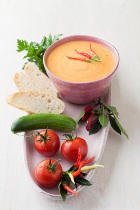 There are plenty of foods we should be including in our diets to keep us healthy, fill us up and satisfy our taste buds. Eating well should be neither difficult nor an unpleasant experience. The key is to make sure the majority of the foods and drinks we consume are good healthy choices that we enjoy, then save other foods for small treats.
There are plenty of foods we should be including in our diets to keep us healthy, fill us up and satisfy our taste buds. Eating well should be neither difficult nor an unpleasant experience. The key is to make sure the majority of the foods and drinks we consume are good healthy choices that we enjoy, then save other foods for small treats.
What should I be eating?
Have a good think about what types of foods you eat every day for breakfast, lunch and dinner. Do those three meals combined offer plenty of foods from the four main food groups?
- Breads & cereals
- rice, pasta, potatoes, breads, wholegrains
- Fruits & vegetables
- fresh, frozen, canned all count – as does one serving a day of juice or dried
- Dairy products or alternatives
- Low fat milks, yoghurts, ice cream, cheese, soy milks
- Meats & alternatives
- Red meats, chicken, fish, pork, eggs, nuts, legumes
How should I prepare these foods?
The Food and Nutrition Guidelines from our Ministry of Health encourage us to eat from these four groups of foods every day. When choosing or preparing these foods make sure that fat, salt and sugar are kept to a minimum. Simple changes can make a big difference, for example:
- Trim all excess fat from meats, remove skin from chicken
- Use low fat dairy products where you can
- Choose canned fruits in natural juice
- Don't add extra salt to cooking and use oils sparingly (try using a spray oil to grease a frying pan in place of pouring from a bottle)
- Use cooking methods like steaming, grilling, baking, and stir fry – instead of roasting and deep frying
What should my plate look like?
It's important to balance the foods from these groups. Have a good look at your dinner plate. The meat should contribute to about a quarter of the plate, same with the rice/pasta or potato. A good half of the plate should be vegetables or salad. Bulking up on lots of fruits and vegetables helps to keep total energy intake down and gives lots of good nutrients for health. Using a mix of fresh, frozen and canned varieties helps to meet the recommended five servings each day. Have a fresh juice sometimes as well – the new 'juice bars' offer lots of interesting fruit and vegetable mixes to choose from.
Are there any healthy snacks?
Once you have your meals in good shape, you should look at how you are snacking. Remember you should only have snacks if you are hungry, not simply because you are bored or it's a habit. Choose snacks that offer some good nutrition but are not too high in fat, salt or sugar, such as;
- Fruit – fresh, dried or pottles
- Yoghurt
- Low fat cheese and water crackers
- Raw almonds or other nuts
- Mug of soup
- Vegetable sticks or pita breads with hummus dip
What about 'treat' foods?
Save the foods that offer little in the way of nutrients, yet provide excess energy and can lead to weight gain, for special occasions or treats. When you do have these, keep the portion sizes small. For example; have a mini 'treat' size chocolate bar in place of standard size. Avoid giant sized biscuits, have a couple of mini sized ones instead. Buy small packets of crisps rather than large – even for the family. Choose 'diet' versions of soft drinks if you drink these products often.
Eating well in a nutshell!
Eating well for your health's sake is all about making good choices from a wide variety of foods across the four main groups. It's also about being sensible with portion sizes – don't overeat by piling your plate too high or choosing 'giant' portions. Most importantly – make time to choose foods you enjoy, then prepare them well and make your mealtimes a happy occasion.
You might also like: Hungry at work?










Join the Discussion
Type out your comment here:
You must be logged in to post a comment.